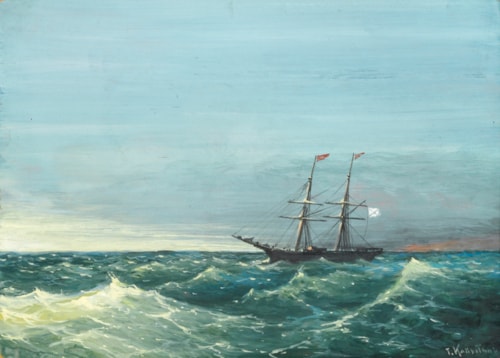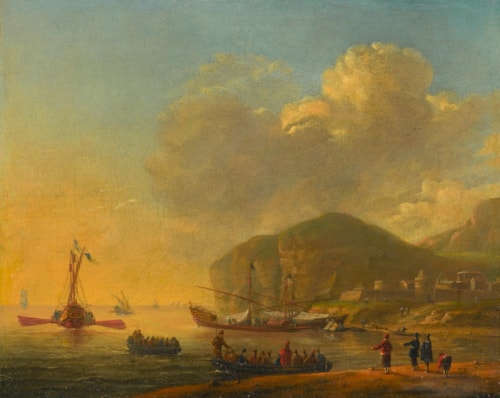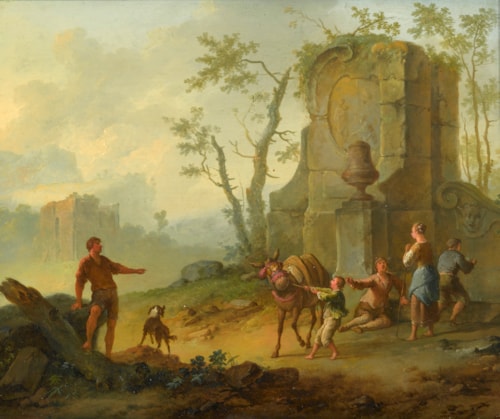. de Beer
(Dutch, active 1750 - 1777)
Tsar Peter the Great Viewing the Mock Sea Battle Held in his Honour in the IJ, off Amsterdam, 1st September 1697
signed and dated ‘i.D.BEER.fecit.76’ and inscribed ‘NV:’ and ‘IM’ (lower left, on one of the boats)
oil on panel
44.5 x 67.5 cm (17½ x 26½ in)
The present work depicts Tsar Peter the Great (1672-1725) inspecting the Dutch fleet during his famous visit to the Netherlands in 1697. The Tsar travelled incognito, as Pieter Michaeloff, to Zaandam, which was the centre of Dutch shipbuilding. Dutch shipwrights were world renowned as pioneers in naval technology, which was recognised by the Tsar as essential to commerce, defence and national prosperity. He lived in a labourer’s house with Gerrit Kist, whom he had met in Moscow, and signed up as an apprentice carpenter at the shipyard. However, his identity was impossible to hide and he was quickly attracting large crowds wherever he went. Unable to carry out his original plan the Peter left Zaandam within a week and travelled to Amsterdam. His arrival on the 25th August was met with a series of celebrations, including fireworks and festivities, before culminating on the 1st September in a maritime review and a mock sea battle, which is depicted in the present work. Forty-one ships took part and Peter was so delighted by the display that he transferred to a vessel which was constantly in the line of fire, and it is thought that he wanted the whole performance repeated a week later.
The present work is derived from the famous interpretation of the scene by Abraham Storck (1644-1708) of which there are several versions, including Mock Battle on the IJ on the Occasion of Czar Peter the Great’s Visit, 1 September 1697 in the Amsterdam Museum. Storck’s painting was disseminated further through a famous print by Caspar Luyken (1672-1708). The present work was painted almost eighty years later, and although the circumstances surrounding its commission are currently unclear, the subject evidently had enduring appeal.
The Tsar, dressed in red, stands in the yacht on the left-hand side, observing the scene. A trumpeter is also on board, playing a fanfare. This yacht flies the Russian tricolour with a double-headed eagle. The design of the flag derived from the Dutch colours and this occasion was one of the very first on which it was flown. The large yacht in the centre was under the command of Gillis Schey, the commander in chief, and it flies the flag of the Dutch East India Company.
The present work is signed ‘i.D.BEER’ and the enigmatic artist has tentatively been identified as Joachim de Beer, who was active as an engraver during this period. Works bearing his signature include a depiction of a polar bear hunt,¹ as well as a pair of moonlit river scenes.
¹ Sold Sotheby's, Amsterdam, 3 May 1999, lot 72.
The present work depicts Tsar Peter the Great (1672-1725) inspecting the Dutch fleet during his famous visit to the Netherlands in 1697. The Tsar travelled incognito, as Pieter Michaeloff, to Zaandam, which was the centre of Dutch shipbuilding. Dutch shipwrights were world renowned as pioneers in naval technology, which was recognised by the Tsar as essential to commerce, defence and national prosperity. He lived in a labourer’s house with Gerrit Kist, whom he had met in Moscow, and signed up as an apprentice carpenter at the shipyard. However, his identity was impossible to hide and he was quickly attracting large crowds wherever he went. Unable to carry out his original plan the Peter left Zaandam within a week and travelled to Amsterdam. His arrival on the 25th August was met with a series of celebrations, including fireworks and festivities, before culminating on the 1st September in a maritime review and a mock sea battle, which is depicted in the present work. Forty-one ships took part and Peter was so delighted by the display that he transferred to a vessel which was constantly in the line of fire, and it is thought that he wanted the whole performance repeated a week later.
The present work is derived from the famous interpretation of the scene by Abraham Storck (1644-1708) of which there are several versions, including Mock Battle on the IJ on the Occasion of Czar Peter the Great’s Visit, 1 September 1697 in the Amsterdam Museum. Storck’s painting was disseminated further through a famous print by Caspar Luyken (1672-1708). The present work was painted almost eighty years later, and although the circumstances surrounding its commission are currently unclear, the subject evidently had enduring appeal.
The Tsar, dressed in red, stands in the yacht on the left-hand side, observing the scene. A trumpeter is also on board, playing a fanfare. This yacht flies the Russian tricolour with a double-headed eagle. The design of the flag derived from the Dutch colours and this occasion was one of the very first on which it was flown. The large yacht in the centre was under the command of Gillis Schey, the commander in chief, and it flies the flag of the Dutch East India Company.
The present work is signed ‘i.D.BEER’ and the enigmatic artist has tentatively been identified as Joachim de Beer, who was active as an engraver during this period. Works bearing his signature include a depiction of a polar bear hunt,¹ as well as a pair of moonlit river scenes.
¹ Sold Sotheby's, Amsterdam, 3 May 1999, lot 72.





 contact
contact contact
contact +44 20 7313 8040
+44 20 7313 8040









